Fig. 13.1
Jonathan Wyatt, Grossglockner Race, 2007 (Photo courtesy of Peter Hartley)
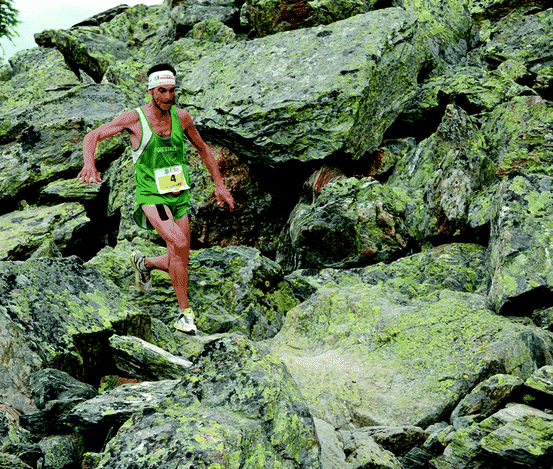
Fig. 13.2
Marco Di Gasperi (six-time world champion and record holder of Mount Kinabalu Climbathon), on target to win Sierre-Zinal Race 2011 (Photo courtesy of Peter Hartley)
Skyrunning
Skyrunning is the discipline of running in mountains above 2,000 m, where the incline exceeds 30 % but the climbing difficulty does not exceed II° grade (hiking up a steep trail). It differs from mountain running in that it takes place at altitude, the courses can be more technical, they avoid asphalt paths (some mountain races are almost entirely on asphalt roads, e.g., the Mount Washington Race), and they tend to include more downhill sections.
The sport is divided into the following categories:
Skymarathon – races with a minimum of 2,000 m total elevation gain reaching or exceeding 4,000-m altitude. Between 30 and 42 km, with terrain incorporating paths, trails, moraine, rock, or snow.
Ultra skymarathon – races that exceed the parameters for a skymarathon by more than 5 %.
Skyraces – races between 2,000 and 4,000 m, and between 20 and 30 km.
Vertical kilometer – races with 1,000-m vertical climb over variable terrain with a substantial incline, not exceeding 5 km in length. These races are categorized into three altitude levels.
Skyspeed – races with 100 m or more vertical climb and more than 33 % incline.
Skyraid – team skyrunning races over long distances which incorporate other sports such as cycling, skiing, and climbing.
The Federation for Sport at Altitude (FSA) was founded in 1995 and was transformed into the International Federation for Skyrunning (IFS) in 2008. A circuit of international standard races in varying countries is selected by the IFS which are open to individuals affiliated to a national sports or mountain federation/association. Approximately 30,000 athletes participate in the official skyrunning races annually with up to 54 countries being represented. The FSA is also responsible for carrying out scientific research on athletes both at altitude and in the laboratory.
The Mount Kinabalu International Climbathon has the reputation as the world’s toughest race and is the steepest race on the sky circuit ascending from 1,866 m to the summit of Mount Kinabalu at 4,095 m. It rises along paths and slippery steps until the summit where runners use fixed ropes for assistance. The first climbathon was inaugurated in 1987 when Sabah Parks tried to find new recruits for the rapid rescue team – where an individual’s fitness was essential to help bring injured climbers off the mountain as quickly as possible. Entry was initially restricted to Malaysians, but the following year was opened for international participation. The race record is held by six-time world champion mountain runner, Marco di Gasperi, in 2 h 33 min and 56 s (2010).
Endurance Running
Endurance races often take competitors to the extremes of nature – temperature (−30 to 56 °C), altitude (up to 5,184 m), terrain (on- or off-road, desert, glacier, or jungle), isolation – or a combination of any. The competitors have the desire to overcome what appears to be seemingly impossible physically and mentally, with the event sometimes being more of a personal challenge.
The races take place in some of the remotest parts of the world (the Sahara Desert (Fig. 13.3), the Himalayas, and both Arctic and Antarctic Circles) and vary in distance from that of a marathon (26.2 miles) to hundreds of kilometers. The world’s longest certified race is the Sri Chinmoy’s 3,100-mile race.
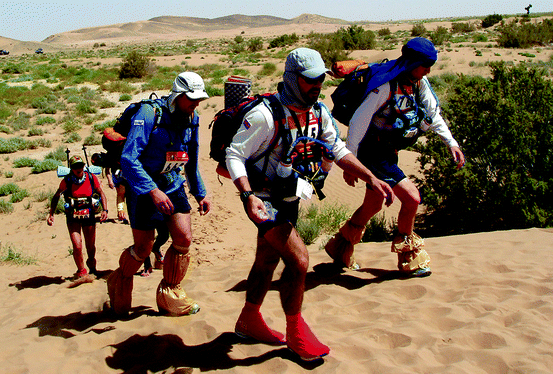

Fig. 13.3
Marathon de Sables 2007 (Photo courtesy of Steven Worralio)
Endurance races can be categorized into:
Ultramarathons (e.g., Comrades Marathon)
Ultra-trails (e.g., Ultra-Trail du Tour du Mont-Blanc)
Trail/mountain marathons (e.g., Everest Marathon)
Multistage footraces (e.g., Transalpine Run)
The International Association of Ultrarunners (IAU) came into existence in 1984, and there are now more than 1,000 ultra races around the world, with over 100,000 runners. The IAAF granted its patronage to the IAU in 1988, and the 100-km race became a standard distance recognized by the federation.
The Equipment Used: Essential and Safety Requirements/Considerations
Mountain running attracts competitors with a wide range of abilities and experiences. Individuals with limited experience are more at risk in the challenging conditions, and it is essential that runners take responsibility for their own safety. If injury causes a runner to stop running or slow down, body heat can be lost very quickly, creating a high risk of hypothermia.
The two items of equipment essential to mountain running are appropriate clothing and footwear. Equipment must be lightweight and comfortable to the individual so as not to impede running, but it must be durable and functional to be effective (Fig. 13.4).
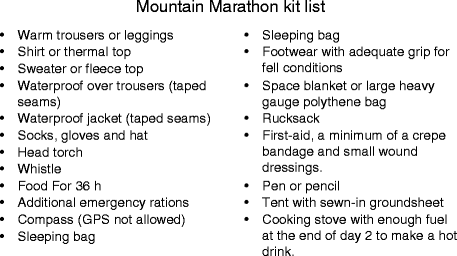

Fig. 13.4
Mountain marathon kit list
Clothing
With the advent of modern fabrics, there are now vast selections of garments available. It is important to consider body temperature and dryness from both the inside (perspiration) and the outside (precipitation). Layering of clothing allows the runner to adapt clothing in response to changes in temperature and weather conditions, which occur rapidly at altitude or in mountainous conditions. Technological breakthroughs have enabled garments to be produced that are breathable, windproof, waterproof, lightweight, antibacterial, lightweight, and that wick away any personal moisture. Runners must carefully assess conditions before selecting appropriate apparel for both training and racing as this could be crucial for safety. In good weather, a lightweight running vest and shorts might be sufficient, whereas waterproof, full body protection may be necessary in adverse conditions.
Footwear
When selecting footwear, the runner needs to take into account:
Terrain
Distance
Biomechanics (especially if they have a tendency to pronate or supinate)
Personal weight
Foot width
Gender (some shoes are now manufactured on a narrower last more suitable for females)
Any preexisting medical conditions which would suggest a particular shoe might be more beneficial – e.g., a runner with osteoarthritis or rheumatoid arthritis would benefit from more cushioning
The weight and unique design features of a particular shoe at higher levels of competition
The shoe needs to provide flexibility and speed, but comfort, traction, support, stability, motion control, cushioning, breathability, and, at times, protection from rocks must be considered. Sometimes advanced lacing or webbing systems are used to help hold the foot stable within the shoe, and various soles have been developed ranging from pyramid “studs” for mud to a “sticky rubber” for grip on wet rock. The shoe uppers need to be quick drying and allow any water collecting in the shoe to easily seep back out. The most suitable shoe for a short race through mud is completely different to that for tricky rocky terrain or a 2-day event carrying overnight equipment. Runners often have several pairs of running shoes to suit the varying conditions. Some of the market leaders are Salomon, Inov-8, Montrail, Walsh, and La Sportiva.
Climate
The climate is a serious factor, and representatives from the various committees and race organizers must decide whether weather conditions are suitable for races to proceed as planned. Where adverse weather conditions could endanger competitors, marshals, or volunteers assisting at the race, the race may be abandoned or a safer alternative course is used. It is the responsibility of the race organizers to make sure that the course is as safe as possible and not unnecessarily dangerous.
Food and Drink
A runner may need to carry food and drink while racing or on long-training runs to avoid hypoglycemia or dehydration. It is a race requirement in some events, but athletes are generally advised to carry sufficient supplies whenever they are racing for longer than 1 h [1].
Altitude
The skyrunning races and some of the mountain and endurance events involve racing at altitude. When the athlete resides at a much lower level and has little time to acclimatize, they must be very careful in appropriate race preparation. Athletes often train at altitude to benefit from the physiological adaptations when racing at sea level, but racing at altitude is the opposite extreme and places serious demands on the body. The effects of altitude on the heart generally begin around approximately 1,000 m (3,048 ft) above sea level. Runners are advised to train at altitude of approximately 8,000 ft for at least 4–5 days before running above 13,000 ft, although if they live above 6,500 ft is not always necessary. The guidelines suggest that once above an altitude of 2,500 m, the altitude at which one sleeps should not be increased by more than 600 m in 24 h, and that an extra day should be added for acclimatization for every increase of 600–1,200 m in this altitude [2].
Altitude and acclimatization are taken very seriously by organizers of races such as the Everest Mountain Marathon. This race is preceded by a 15-day trek in the Everest region to allow for acclimatization, all while under careful medical supervision [3]. Physical fitness is not protective against high-altitude illness [2], but instead it seems to be influenced by the rate of ascent, the altitude achieved, the height at which the person sleeps (sleeping altitude), and the individual’s physiology. Skyrunners may adapt their running style when racing at altitude by generally slowing down, shortening their stride, and walking where the gradient exceeds 25 %.
Safety Requirements
The WMRA does not impose any specific safety requirements, but the Fell Runners Association in England, the International Ski Federation, and races such as the Original Mountain Marathon (OMM), which is a 2-day mountain marathon, all carry their own regulations. These recommendations are made with the safety of the runner being the main priority (Fig. 13.4).
The FRA requires competitors to arrive at races prepared to carry body cover appropriate for the weather conditions, a map, compass, and whistle, and emergency food in long races. Race organizers can also impose additional safety requirements or waive some of the requirements in settled, fine weather.
In skyrunning races, the use of ski poles is permitted, although this is regulated by each race organizer. It is compulsory to have windproof jackets, trail-running shoes, and socks, plus it may be a requirement to carry tights, gloves, water, helmets, and sunglasses. The recommended equipment for each skyrunning race is stated in the race briefing.
The 2008 Original Mountain Marathon in England suffered from sudden adverse weather conditions. The race had over 2,000 competitors scattered over the fells and had to be abandoned due to torrential rain and high winds. Previous experience of the competitors – a requisite to participating in the event – along with the safety equipment carried by the athletes ensued there were no fatalities and only one reported injury.
Injury Demographics, Mechanisms, and Rates
Injury Rates
As yet there are few published studies regarding the frequency and type of injuries specifically experienced by mountain runners, although a systematic review published in 2007 reported on the incidence and determinants of lower extremity running injuries in long-distance runners [4]. The literature published on ultra races, the Marathon Des Sables and the World Deca Iron Triathlon, has focused on weight and body water composition changes related to performance and is probably beyond the scope of this text [5, 6]. Analysis of the presenting complications reported by the 69 competitors in the 219-km Al Andalus 5-day ultramarathon stage race showed that in this competition over half (56.5 %) reported injuries. The majority of these were minor with foot blisters comprising 33.3 % and chafing 9 %. Lower limb musculoskeletal injuries accounted for 22.2 % and predominantly affected the knee [7]. Van Gent’s review included studies where subjects ran >5 km per training or race, which, while useful, is not totally representative of mountain, sky, and ultradistance running.
Park has conducted a questionnaire survey of the injuries experienced by mountain, sky, and endurance runners over a 6 months period identified sites of injury, possible causes, and subsequent treatments received. As the runners were unable to be medically assessed and diagnosed accurately, they were asked to stipulate the area of injury rather than the specific medical diagnosis. The survey population comprised of 200 runners from 11 countries −100 competing at international level including 6 previous world champions and 100 “club” runners.
Of the 200 responses, 142 runners (71 %) reported at least one injury during the previous 6 months, although this was not necessarily representative of the frequency of injuries in the sport. Twenty-seven percent of the runners reported more than one injury suggesting some may have been compensatory.
For the male athletes, the number of injuries increased as the standard of the athlete decreased (33 % of non-GB international athletes reported injuries, compared to 89 % of club athletes). Van Gent similarly found that an increase in training distance per week appeared to protect the individual against knee injuries, rather than being causative [4].
The most commonly reported injury in Park’s survey was to the knee (22 %), followed by the shin or calf muscles (15 %), foot (14 %), ankle (12 %), thigh muscles – hamstrings or quadriceps (10 %), pelvis/buttocks (9 %), Achilles tendon (9 %), spine (8 %), and upper body (1 %) (Fig. 13.5). The majority of these injuries were overuse in nature particularly tendinopathy and tenosynovitis.
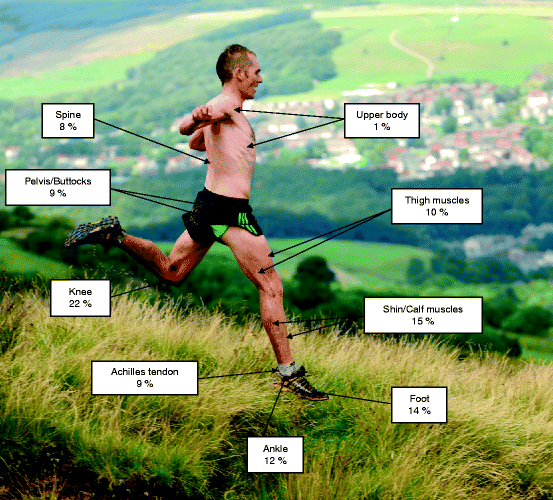
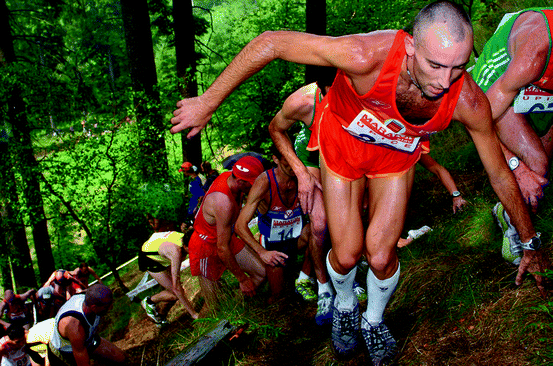

Fig. 13.5
Percentage of injured areas experienced by mountain runners (Photo courtesy of Peter Hartley)

Fig. 13.6
European Mountain Running Championships 2006 (Photo courtesy of Peter Hartley)
The males had a much higher incidence of knee injuries compared to the females (Table 13.1) despite studies suggesting females experience a higher incidence of sports-related knee pain [8]. Females reported more foot injuries, although the reasons why require further investigation.

Table 13.1
Frequency of injuries

The higher incidence of male knee injuries could be because:
Mountain runners do not have a repetitive running style, so factors such as the Q-angle may not be as relevant.
Males may land with more impact, particularly when running downhill (taller or heavier subjects are at a greater relative risk of injury because of the greater forces acting on the bones, muscles, and connective tissue) [9].
Males may be more reckless when descending, although clearly this is objective.
Females tend to be more diligent and incorporate core stability and Pilates type exercises into their training schedule, which could be particularly beneficial to lower limb biomechanics when running downhill [10].
Fatalities
Fatalities due to mountain running are rare, but adverse weather conditions while training or racing can result in exposure, fatigue, hypothermia, and occasional tragedy.
In 2008, 2 runners were killed and 6 seriously affected in the Zugspitze Mountain Race in Germany. A sudden change in weather brought temperatures below freezing point, with strong gusts of wind and snow. Five hundred runners were competing in the race, most of them only clad in t-shirts and shorts, but the fitness of the individuals involved helped most of them cope with the extreme conditions [11].
There have been very few deaths reported when weather has not played a major factor, but the consensus of opinion is that these deaths have been due to other preexisting conditions such as heart disease or congenital abnormalities. While this has been proven in road marathon running, no specific studies are available relating to mountain running [12].
Specific Types of Injury
Some injuries occur more frequently in mountain running because of the unique demands placed on the body when running steep ascents or descents. The common injuries associated with running are documented sufficiently in other sports’ injury textbooks, but some of the more obscure injuries deserve specific attention.
Runner’s Knee
Runner’s knee – possibly more aptly named mountain runner’s knee – is the most frequent injury encountered by those regularly providing medical treatment for mountain runners, with almost a quarter of survey respondents complaining of this problem.
Noakes and Grainger [13] suggested that this is the most common injury associated with distance running but, combined with the biomechanics of the knee while mountain running, explains why it is so prevalent. Other textbooks refer to it as patellofemoral stress syndrome, lateral patellar compression syndrome, peripatellar syndrome, and retinaculitis [14].
The symptoms and signs are:
Pain located around the patella.
Full, pain-free movement of the knee joint, although pain may be present on maximum flexion due to the stretch on the affected structures (the elicited pain feels more anterior than intra-articular).
Increase in pain when increased quadriceps recruitment – e.g., cycling stood on the pedals, walking up, and especially downstairs.
Increased symptoms running downhill.
Increase in pain after sitting long periods, especially when >90° knee flexion.
Painful kneeling/squatting.
Driving may irritate symptoms, especially if stiff pedals or maintaining a sustained position on the accelerator pedal.
The symptoms often ease while running but may return later in the run.
Possibly no memorable history of trauma, although there may have been either of the following:
(a)
A single maximal load such as a sudden change in direction
(b)
Multiple submaximal loads causing repetitive microtrauma
On clinical examination, there is:
Localized tenderness along the border of the patella, often the inferomedial aspect, where the quadriceps retinacula and patellar ligament attach to the patella.
No other obvious bone lesions/positive joint signs or intra-joint/retropatellar crepitus. Clarke’s test (resisted patellar movement) is not necessarily indicative of this condition, as this test is positive in 66 % of subjects with normal knees [15].
Lumbar pain, pelvic pain, buttock pain, and thigh pain are all common in mountain running and often remain misunderstood and misdiagnosed by medical practitioners due to the confusing clinical presentation.
Running up- or downhill alters the pelvic tilt considerably (Fig. 13.6 and 13.7), affecting the body’s biomechanics. The structures that are associated with the lumbosacral spine, pelvis, buttocks, and hips (Fig. 13.8 and 13.9) are exposed to unaccustomed stresses which are completely different to those of flat, propulsive road running.
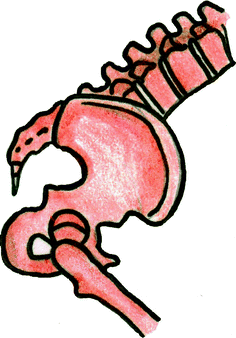
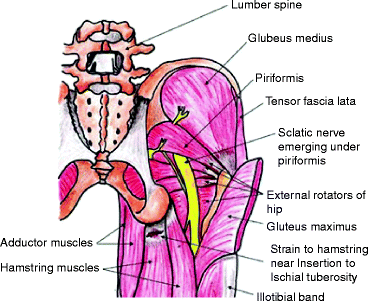
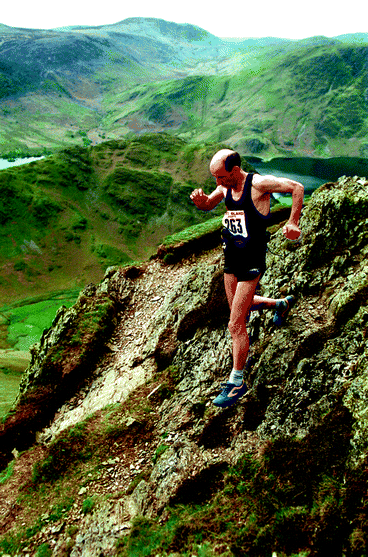

Fig. 13.7
Pelvic tilt in uphill running (Photo courtesy of Peter Hartley)

Fig. 13.8
A superior hamstring lesion and the associated structures (Photo courtesy of Peter Hartley)

Fig. 13.9
The terrain of an English Fell Race – Ian Holloway descending Sailbeck, 1998 (Photo courtesy of Peter Hartley)
If eccentric loading exceeds eccentric strength (as in downhill running), there is an additional risk of accumulative microtrauma.
While minor lesions are initially asymptomatic, the continuous cycle of repair, reinjury, and re-inflammation ultimately becomes problematic, with compensatory damage occurring in the closely related structures [15].
The possible signs and symptoms are:
Gradual onset of diffuse pain in the low lumbar region, buttock, groin, or thigh.
Rest may ease the symptoms, but any return to activity results in a recurrence, often more debilitating.
Sitting often irritates the symptoms.
Pain increases while running.
Training and racing may be possible at a lower level until symptoms become too severe.
Occasionally the athlete describes a sensation of paresthesia, although it is usually non-segmental and does not relate to any specific dermatome.
Clinically:
There may not be any apparent lack of movement in the lumbar region, although hamstring mobility may appear restricted.
Very tender “knots” may be palpable in the painful regions.
Muscle weakness may be identifiable, especially when tested eccentrically. A single-leg squat may highlight weakness in the hip abductors or external rotators, which could have a subsequent adverse effect on the lumbar spine, pelvis, and lower limb alignment.
Further investigations do not usually help in the diagnosis of this complex problem, although imaging may occasionally identify a minor disc protrusion or superior hamstring lesions. The MRI report frequently suggests there is nothing untoward, which often causes the runner serious psychological distress. It is important to explain that there may be areas of micro-damage, which have not been identifiable, but the report excludes any serious pathology. The diagnosis of a disc lesion occasionally leads to other associated areas being neglected in the treatment plan, and personal experience has shown that the primary site and the associated areas must be addressed to achieve optimum recovery and avoid any future recurrences.
Tendon injuries are common in running, although mountain running affects different tendons to road running. Flexor hallucis longus (FHL), tibialis posterior, and both peronei tendons are at higher risk around the foot and ankle. FHL tendons have been known to rupture during uphill repetition training sessions. Many of the athletes run on their toes, so the undulating terrain put these structures under considerable stress. Pain is usually localized, and resisted muscle testing of the structure often identifies the problem. If resisted testing is negative (given it is impossible to replicate similar strains within the clinic), palpation is often paramount in locating the site of injury.
In ultramarathon running, the high-mileage training requirement has been associated with ankle extensor tendon tenosynovitis localized at the extensor retinaculum [16, 17]. These comprised 19 % of all injuries sustained during a 1,115-km ultramarathon race from Sydney to Melbourne [16]. Tenosynovitis of the extensor digitorum longus tendon has since been termed ultramarathoner’s ankle [16]. A typical ultramarathoner’s shuffling gait has been suggested as a causative factor in addition to excessive pronation, tight-fitting shoes, muscle imbalance, eccentric overload, and in one case talar head impingement [17].
Continuous overload means that mountain runners are susceptible to stress fractures, with several being reported in the survey. Signs and symptoms are:
Localized pain which may be bearable at rest, but where running is impossible
Usually sudden onset, although it can be insidious
Bony or soft tissue swelling
Tenderness on palpation
Pain on impact – hopping, running on the spot, or jumping
Most runners want evidence of the injury due to the enforced period of rest from running, but radiographs may fail to reveal a fracture until at least 3 weeks post-injury when new bone growth is identifiable.
Osteoarthritis and the development of cardiac damage are often misconstrued as being prevalent in runners, but this is unproven. Animal and human studies have shown no evidence of increased risk of hip or knee osteoarthritis in subjects carrying out moderate exercise (in the absence of any traumatic injury). Sporting activity has even been shown to have a positive effect as a study of recreational runners who ran 12–14 miles per week for up to 40 years showed no increase in either radiological or symptomatic hip or knee OA [18].
Stay updated, free articles. Join our Telegram channel

Full access? Get Clinical Tree








